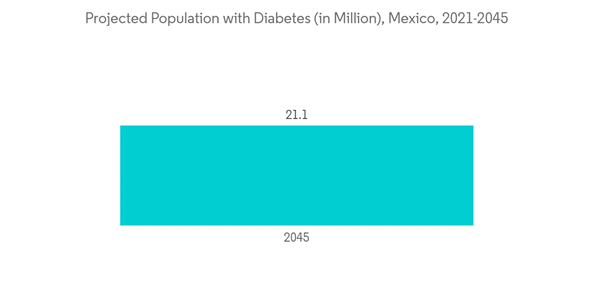The COVID-19 pandemic has impacted the growth of the market. The initial phase of the pandemic decreased the number of organ transplants and surgeries performed in the country. The lockdown measures and the restrictions imposed by the government have resulted in the shutdown of hospitals and surgical centers to avoid the spread of coronavirus among the population. For instance, from an article published in the AJT Journal in August 2021, it has been observed that organ donation and transplantation procedures were greatly reduced in Mexico. In addition, as per the same source, as of June 2021, around 5,831 patients were on the waiting list for a cornea transplant, around 16,890 for a kidney, 48 for a heart, and 323 for a liver transplant. Thus, the reduced transplant procedures impacted the market growth during the pandemic. However, with resumed services and transplantation procedures, the market is expected to witness significant growth over the forecast period.
Certain factors that are propelling the market growth are the increased incidence of disabilities, and organ failures, along with the scarcity of donor organs, the high incidence of road accidents leading to amputations, as well as technological advancements in artificial organs and bionics.
The rising number of chronic diseases among the population is increasing due to the lifestyle issues, such as unhealthy dietary habits, smoking, alcohol consumption, and lack of exercise, which can lead to organ dysfunction, which is the key factor driving the market growth. For instance, as per an article published in AASLD, in January 2022, it has been found that the incidence rate of non-alcoholic fatty liver disease (NAFLD) is highest in Mexican adults. Thus, the high incidence of liver disease among the population is expected to increase the demand for artificial organ transplants, which is anticipated to fuel market growth over the forecast period.
Additionally, smoking and obesity in the Mexican population are found to be the most prevalent heart disease risk factors which are also contributing to the growth of the market over the forecast period. For instance, according to 2022 statistics published by World Obesity Federation, it has been observed that 31.5% of men and 40.2% of women living with obesity in Mexico in 2020. Thus, the obese population in the country increases the risk of developing other chronic diseases and results in organ damage/failure which raises the demand for organ transplants or artificial livers that act as a support system for patients with acute or chronic liver failure. This is anticipated to fuel the market growth over the forecast period.
Furthermore, as per the 2022 data published by OECD, around 21,424 persons were hospitalized due to road accidents in Mexico, in 2020. In addition, as per the same source, 61,421 cases of injury crashes were reported in 2020, in Mexico. Thus, the high number of motor accidents in the country raises the demand for bionics such as orthopedic bionics which in turn is anticipated to fuel the market growth over the forecast period.
However, the expensive procedures and risk of computability issues and malfunctions are likely to impede the market growth over the forecast period.
Mexico Artificial Organs & Bionic Implants Market Trends
Artificial Kidney Segment is Expected to Grow in the Mexico Artificial Organs and Bionic Implants Market Over the Forecast Period
The artificial kidney segment is expected to witness significant growth over the forecast period due to the factors, such as the rising prevalence of renal failures and increasing chronic diseases, such as diabetes and hypertension that lead to kidney disease.A wearable artificial kidney is a wearable dialysis machine. An individual with end-stage renal disease may use a wearable artificial kidney on a daily or even a continuous basis. The increasing incidence and prevalence of renal failures are expected to drive segment growth.
Kidney failure or dysfunction has become a burden in the country, which is expected to increase the demand for an artificial kidneys, propelling the segment growth. For instance, as per an article published in PeerJ Journal in June 2022, it has been found that patients with chronic kidney diseases, diabetes mellitus, and arterial hypertension have a higher prevalence of mortality. Additionally, from an article published in PLOS One in February 2021, it has been observed that acute kidney injury was common in patients with severe pneumonia caused by SARS-CoV-2 infection. The risk factors include old age, obesity, and the requirement of invasive mechanical ventilation (IMV) on admission.
Additionally, as per the data published by CDC, in February 2022, it has been observed that chronic kidney diseases (CKD) cases were increasing among Mexican Americans. In addition, CKD was higher in groups with lower educational levels and income. This is expected to increase the risk of kidney failure among the Mexican population, which is anticipated to fuel the demand for artificial kidneys, propelling the segment growth.
Therefore, owing to the aforementioned factors, the segment is expected to witness growth over the forecast period.
Cardiac Bionics Segment is Expected to Have the Significant Market Share Over the Forecast Period
The cardiac bionics segment is expected to witness healthy growth in Mexico's artificial organs and bionic implants market over the forecast period. The factors attributing to the market growth are the rising prevalence of cardiovascular diseases, such as hypertension, stroke, and their risk-associated factors, as well as the increasing number of cardiac surgeries requiring bionics implantation.The rising burden of heart disease is the key factor driving the demand for cardiac bionics, propelling the segment's growth. For instance, according to an article published in Cardiovascular Diabetology in June 2021, it has been observed that a 45% increase in physical inactivity increased the number of cases of type 2 diabetes, coronary heart disease, stroke, myocardial infarction, stroke deaths, and coronary heart disease diseases. Thus, changing lifestyles leading to physical inactivity can further increase the risk of heart disease, which is expected to increase the demand for cardiac surgeries. This is anticipated to fuel the segment growth over the forecast period.
Additionally, as per an article published in NLM in August 2022, it has been observed that the incidence of hypertriglyceridemia is higher among Mexican Americans compared to white Americans. Thus, the high burden of hypertriglyceridemia among the population increases their risk of developing cardiovascular disease. They thicken the arteries and reduce blood flow to the heart, which may lead to cardiac surgeries. This is anticipated to fuel the segment growth over the forecast period.
Furthermore, according to the 2022 statistics published by IDF, in Mexico, 14.1 million people were living with diabetes in 2021, which is projected to double by 2050. Thus, the high blood sugar from diabetes can damage blood vessels in the kidney and nephrons, leading to kidney disease and kidney failure. This is expected to increase the demand for kidney transplantation, which is anticipated to propel the market growth over the forecast period.
Therefore, owing to the factors such as the rising prevalence of cardiovascular diseases, diabetes, and triglycerides among the population, the segment is expected to grow over the forecast period.
Mexico Artificial Organs & Bionic Implants Market Competitor Analysis
The Mexican artificial organs and bionic implants market is moderately competitive and consists of several major players. Some of the companies, which are currently dominating the market, are ABIOMED, Berlin Heart, Medtronic, JARVIK HEART Inc., LifeNet Health, Össur, Ekso Bionics, Cyberonics Inc., Getinge AB, and Boston Scientific Corporation.Additional benefits of purchasing the report:
- The market estimate (ME) sheet in Excel format
- 3 months of analyst support
This product will be delivered within 2 business days.
Table of Contents
Companies Mentioned (Partial List)
A selection of companies mentioned in this report includes, but is not limited to:
- ABIOMED
- Berlin Heart
- Medtronic
- JARVIK HEART Inc.
- Össur
- LifeNet Health
- Cyberonics Inc.
- Getinge AB
- Boston Scientific Corporation
- Esko Bionics










